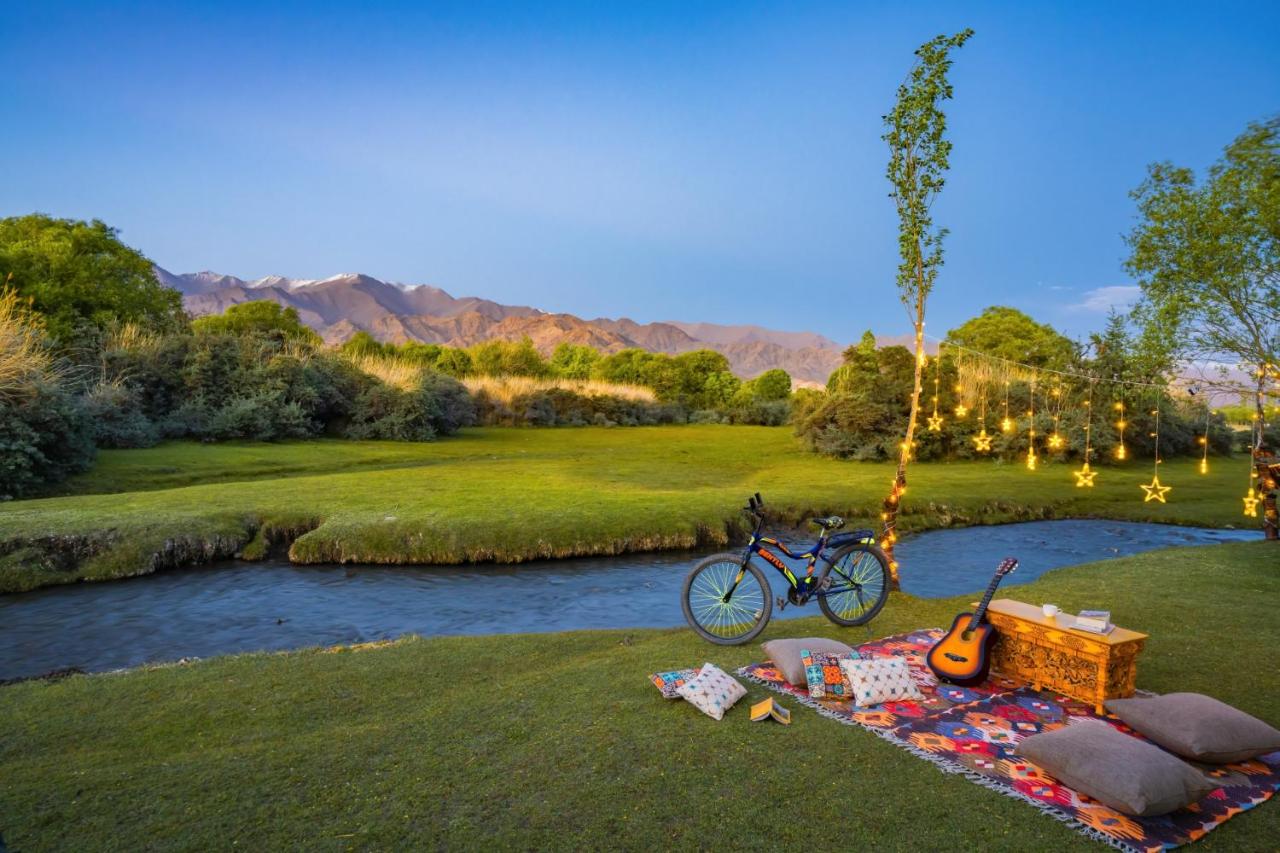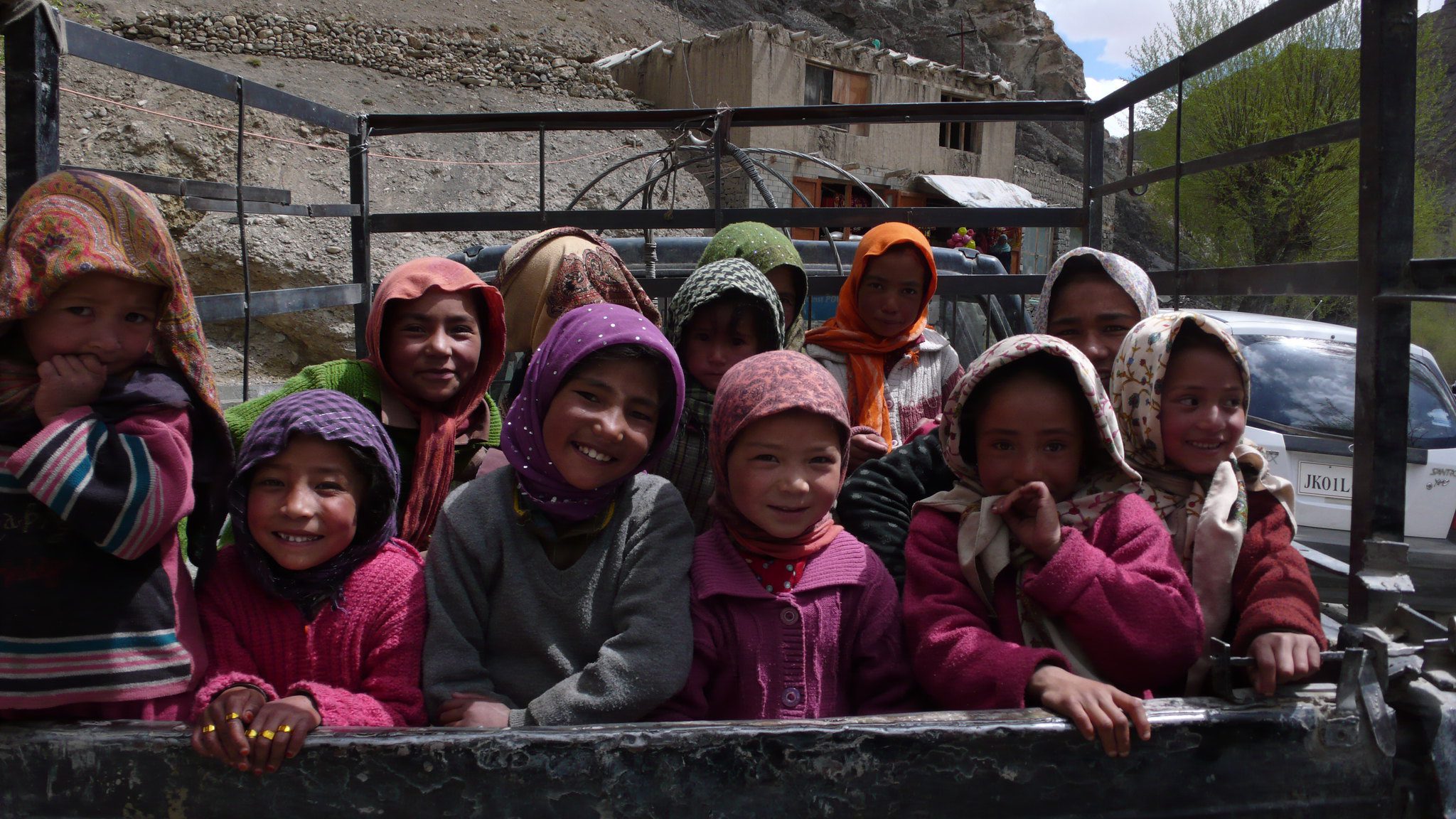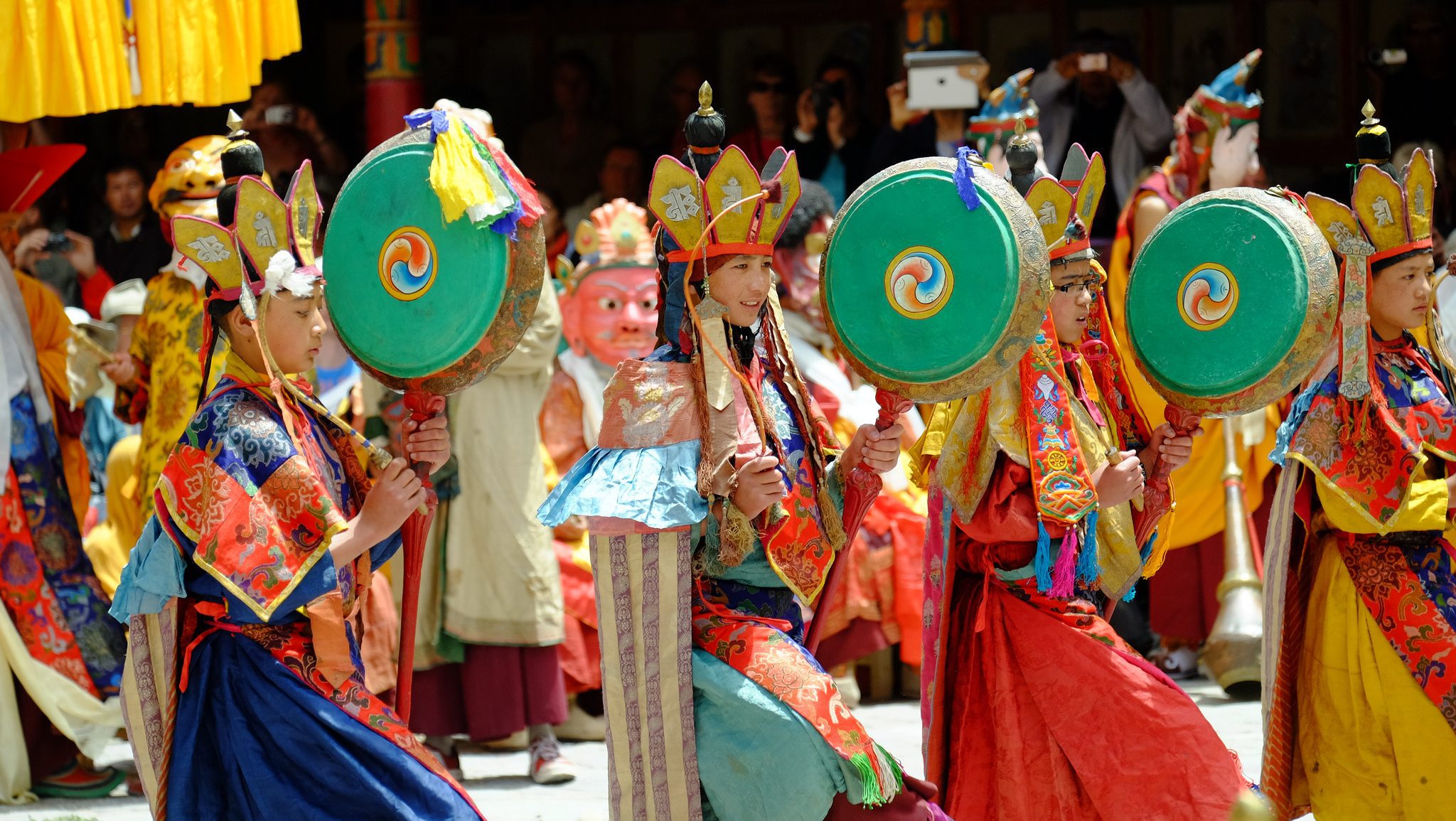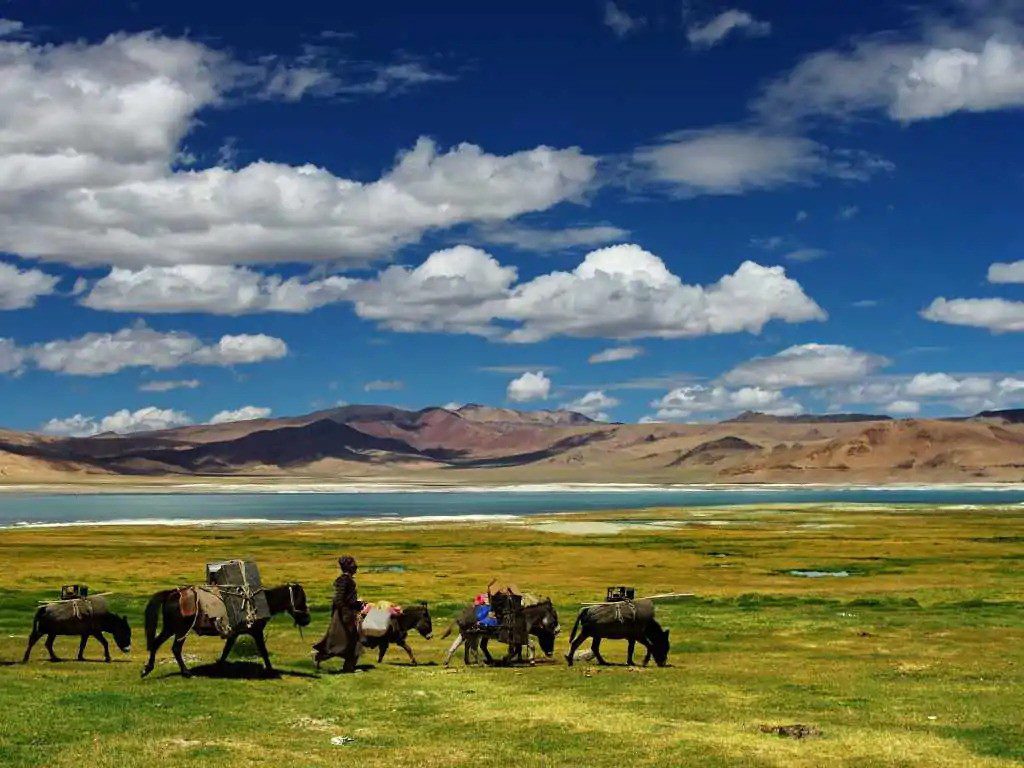Ladakh, also known as “Little Tibet,” is the westernmost region within the Tibetan cultural sphere. Unlike Tibet proper, which is under the rule of the Chinese Communist Party and faces a cultural crisis, Ladakh, ironically due to its association with India, has preserved much of the culture and Buddhism that has been lost in Tibet. It is even said to be “more Tibetan than Tibet itself.”
Location
Ladakh is located in the northernmost part of India, between latitudes 33° to 35° North and longitudes 76° to 79° East. It is a mountainous and high-altitude region nestled between the Himalayas to the south and the Karakoram range to the north. Administratively, Ladakh is part of the Indian Union Territory of Jammu and Kashmir.
To the south and southeast, it borders Himachal Pradesh and Jammu and Kashmir. To the northwest, it adjoins northern Pakistan, including the region of Baltistan. Crossing the Karakoram range to the north leads to East Turkistan (now the Xinjiang Uyghur Autonomous Region of China). To the east lies the Tibetan plateau, including the Ngari region in Tibet.
India has unresolved border disputes with both Pakistan and China, many of which are centered around the Ladakh region. India claims territories currently under the effective control of Pakistan (Gilgit, Hunza, and Baltistan) and China (Aksai Chin).

Geography
Most of Ladakh lies at an altitude exceeding 3,000 meters, characterized by rugged mountains and high-altitude plateaus. The Changthang Plateau in eastern Ladakh stretches above 4,000 meters.
The Indus River, originating near Mount Kailash in Tibet, flows southeast to northwest through Ladakh. Its major tributaries include the Shyok River, Suru River, Zanskar River, Sanggye Lungpa, Wakha Rong, Suru River, and Dras River. Towns and villages are concentrated along these river basins.
Ladakh is surrounded by significant mountain ranges: the Himalayan range to the south, the Zanskar range, the Ladakh range, and the Karakoram range to the north and northwest. These ranges feature numerous peaks over 6,000 meters, with the Karakoram range in eastern Nubra housing many peaks exceeding 7,000 meters. The highest point in Ladakh is the Saser Kangri peak at 7,672 meters. Other notable peaks include Nun (7,135 meters) and Kun (7,087 meters) in the Himalayan range, as well as Stok Kangri (6,121 meters) in the Stok range.
Eastern Ladakh is home to several lakes, including Tso Moriri, Tso Kar, and Pangong Tso. Many of these are saline or brackish endorheic lakes with no outlets.
Large glaciers are found in the high-altitude areas, particularly along the main Himalayan and Karakoram ranges.
Climate
Ladakh, like Tibet proper, has an extremely arid climate with very little precipitation. The monsoon rains that bring heavy rainfall to much of India during the summer are largely blocked by the Himalayan mountains, leaving Ladakh mostly dry. The region receives an annual rainfall of just 84 mm, which is roughly one-eighth of what Delhi experiences. Even in winter, snowfall is relatively light and melts quickly.
Winter temperatures can plunge to as low as -20°C, creating an extremely cold environment. In contrast, summer days can reach up to 30°C due to the intense sunlight. However, even in summer, the nights are significantly cooler, leading to a saying that Ladakh experiences both summer and winter in a single day.

Ethnic Groups
While the Tibetan culture of the Ladakhi people often garners the most attention, the region’s ethnic composition is much more complex:
Ladakhi (Ladakhi)
- Origins: A Tibetan ethnic group that constitutes about half of Ladakh’s population. The Ladakhi people are a blend of Tibetans who migrated after the 10th century and the indigenous Indo-Aryan Dardic people.
- Language: They speak Ladakhi, a western Tibetan dialect.
- Religion: Most are Buddhists.
Changpa (Changpa)
- Origins: A Tibetan ethnic group living on the Changthang Plateau in eastern Ladakh. They are considered pure Tibetans and are closely related to the people of Ngari in western Tibet. Many are refugees who crossed the border.
- Language: Speak Tibetan and Ladakhi.
- Religion: Predominantly Buddhist.
Purigpa/Balti
- Origins: A Tibetan ethnic group in western Ladakh (Kargil area) and Baltistan. They have stronger Indo-Aryan ancestry than the Ladakhis.
- Religion: Mostly Muslim, with many following Shia Islam.
- Language: Speak Balti, a western Tibetan dialect that retains an older form of Tibetan compared to Ladakhi.

Drokpa/Brokpa
- Origins: An Indo-Iranian ethnic group and a branch of the Dardic people. Once spread throughout Ladakh before the 10th century, most have since intermixed with or assimilated into Tibetan groups. Today, they primarily reside in the lower Indus Valley, particularly in Dah and Hanu.
- Language: Speak Drokke, an Iranian language closely related to Shina, spoken in Gilgit.
- Culture: Known for their exotic facial features and colorful traditional attire.
Mon
- Origins: The term “Mon” is used by Tibetans to refer to people from India or the southern regions. In Ladakh, it describes people who settled in the region from the Indian plains or Kashmir since ancient times. Their exact origins are unclear and may include Indo-Aryans and Kirata Mongoloid groups.
- Current Status: Most Mon people later mixed with Dardic and Tibetan groups. Today, the term refers to a small caste of hereditary musicians who are visually indistinguishable from Ladakhis.
Arghon (Arghon)
- Origins: A mix of Indo-Aryan and Turkic ancestry, they are descendants of traders from East Turkistan or Kashmir. Some reportedly remained in Ladakh after border closures during pilgrimages to Mecca.
- Religion: Predominantly Sunni Muslim.
- Location: Most reside in Leh.
Others
- Seasonal migrant workers or settlers from various parts of India, including Kashmir.
- Tibetan refugees, many of whom have established colonies throughout Ladakh.
- Sherpas from Nepal also reside in Ladakh.
Language
The spoken language in Ladakh is Ladakhi, a western Tibetan dialect widely used in the region. Its primary difference from standard Tibetan lies in pronunciation, which is lower-pitched and closer to the ground. This can make it difficult to understand even for those familiar with Tibetan. Ladakhi also includes many unique words not found in Tibetan. While Tibetan script is used for writing, many Ladakhis cannot read or write in it.
In Purik (Kargil area), the primary language is Balti. Urdu, as the official language of Jammu and Kashmir, is also widely understood in Ladakh, and many signs and official documents are written in Urdu.
In recent years, English has become increasingly common, particularly among young people and those working in the tourism industry. Travelers generally find it easy to communicate in English throughout their journey.
Culture
The culture of Ladakh is deeply influenced by Tibetan culture, particularly Tibetan Buddhism. However, Ladakh has preserved many unique local customs, which are fascinating for travelers.

Calendar
Ladakh uses the same lunar calendar (Tibetan calendar) as Tibet. All annual festivals and events are scheduled according to this calendar, which means the corresponding dates in the Gregorian calendar vary each year.
New Year (Losar) typically falls in late February or early March on the solar calendar. However, in Ladakh, Losar is celebrated two months earlier, on the 1st day of the 11th month of the Tibetan calendar (around December to early January on the solar calendar). This tradition dates back to the 1600s, when King Jamyang Namgyal declared an early Losar celebration before embarking on a military campaign against Baltistan. This unconventional timing for Losar has continued in Ladakh ever since.
Marriage
Historically, Ladakh followed the Tibetan tradition of polyandry (one wife with multiple husbands). However, after India’s independence, polyandry was outlawed, and monogamy became the standard.
Funerals
The traditional Tibetan practice of sky burials is no longer observed in Ladakh. Instead, cremation is the norm. Cremation takes place in community-built earthen kilns called “Pulkhan”, located on the outskirts of villages. During the ceremony, monks chant prayers, and the deceased is cremated in one of these kilns. A small portion of the ashes is used to create “tsatsa” (small clay figures or miniature stupas), while the rest is scattered around the cremation ground.
Cuisine
Similar to Tibet, traditional Ladakhi cuisine centered around tsampa (roasted barley flour) mixed with butter tea to form dough-like balls. On special occasions, dishes like thukpa (Tibetan noodle soup) and momos (Tibetan dumplings) were served.
However, with increased interaction with the Indian plains, ingredients from India have become widely available in Ladakh. Today, meals commonly include dal (lentils), sabzi (vegetable curry), chapati, and rice.
Ladakhis, like Tibetans, drink butter tea (gur-gur cha) frequently, which helps combat dehydration in the dry climate and provides protection against chapped lips due to the butter content. It also serves as a source of vitamins. Nowadays, sweet milk tea (chai), made with black tea and milk, is becoming more popular in Ladakhi households.
Ladakhis also enjoy chang, a low-alcohol fermented barley drink similar to Tibetan beer. It has a cloudy appearance and a slightly sour taste. However, overindulgence in chang can cause severe headaches, especially when combined with the effects of high altitude.
When chang is distilled, it becomes ara, a stronger alcoholic drink. Both chang and ara are homemade and not commercially produced. They can only be obtained through personal connections.

Clothing
Ladakhi clothing is distinctive, with the silk hat known as “Tibi” or “Gonda” serving as a symbol of Ladakh. This mountain hat is worn by both men and women, although nowadays it is rarely seen in daily life. Instead, it is mostly worn as part of festive attire during celebrations.
For more formal occasions, such as weddings, women wear a traditional headdress called “Perak”. This ornament extends from the forehead down the back and is made of a woolen strap adorned with numerous turquoise stones, with flaps resembling elephant ears attached to either side. Peraks are heirlooms passed down through generations.
In their ceremonial attire, women also wear jewelry made from silver, set with turquoise stones, orange coral, and sometimes an enigmatic gemstone called “Zui”, which is incorporated into necklaces. Other ornaments include necklaces, brooches, bracelets, and earrings.
Due to the cold climate, both men and women wear thick woolen coats called “Goncha” as outerwear. These are paired with woolen trousers known as “Gostun” or “Kyastan.” Traditionally, pointed woolen boots called “Bapu” were worn, though these are now rarely seen. For ceremonial occasions, women often don embroidered mantles called “Bok.” Among farmers and herders, goat leather mantles called “Rokpa” (with the fur side facing inward) are still commonly used.
However, like other cultural practices, traditional clothing in Ladakh has seen significant Indianization and Westernization in recent years. Among the younger generation, women often wear Punjabi dresses, while men prefer Western-style shirts and trousers as everyday attire.

Healthcare
Ladakh has traditional healers known as “Amchi,” who practice medicine based on Tibetan medical traditions. Diagnosis typically involves pulse readings, and treatments rely on herbal remedies.
In recent years, hospitals and health centers have been established across the region, providing opportunities for modern medical care. Nevertheless, Amchi practitioners remain highly respected within their communities. In some cases, Amchi also serve as “Lhabas” or “Lamos” (spiritual mediums), combining their roles as healers and spiritual guides.
Religion
Although Tibetan Buddhism is often the focus when discussing Ladakh, nearly half of the population practices Islam (with most Muslims residing in the Purik region). Rather than being a purely Buddhist cultural zone, Ladakh is better understood as a “boundary or mixed region between Buddhist and Islamic cultural spheres.”

Buddhism
Buddhism is believed to have reached Ladakh as early as the 2nd or 3rd century CE, traveling via Kashmir as part of Indian Buddhist expansion. By the 8th and 9th centuries, Buddhism from the then-advanced region of Kashmir flourished in Ladakh, leaving behind numerous stone carvings and rock sculptures that still remain as its legacy.
In the 10th century, descendants of the Tibetan imperial dynasty established the Guge Kingdom in western Tibet, which included Ladakh. Under royal patronage, there was a strong movement to revive Buddhism, which had declined in Tibet. Scholars and monks were invited from Kashmir and India, and students were sent abroad to study, making Guge and Ladakh major centers of Buddhist revival in the 11th century.
When Buddhism eventually declined in India and Kashmir, its center shifted to Central Tibet. The royal families of western Tibet, including Ladakh, became patrons of the newly emerging schools of Tibetan Buddhism in Central Tibet and continued to actively promote the faith.
Today in Ladakh, the Drukpa (a sect of the Kagyu school) and the Gelugpa (the “Yellow Hat” school led by the Dalai Lama and the largest school of Tibetan Buddhism) are the most prominent sects. Other sects present include Drikung Kagyu (a sub-school of Kagyu), Nyingma (the “Old School”), and Sakya (associated with Mongol influence).
Buddhism is deeply embedded in the daily lives of the Ladakhi people. Almost every household has a prayer altar, and it is customary for each family to dedicate at least one member to becoming a monk or nun. Daily rituals include morning and evening prayers, temple visits, and making offerings. Ladakh is home to an astonishing number of monasteries and temples, supported by the offerings of the local community.
Folk Beliefs
Despite the widespread adoption of Buddhism, many pre-Buddhist folk beliefs, rooted in animism, persist in Ladakhi daily life. These beliefs are centered on the idea that spirits inhabit all aspects of nature.
Key Elements of Folk Beliefs
- Lha (Gods): Heavenly deities believed to reside in the sky, mountains (as guardian deities, or Yul Lha), or as war gods (Dara). Lha are central to Ladakhi folk religion.
- Lu (Water/Naga Spirits): Deities associated with water, underground realms, and weather phenomena such as rain and snow. Legends speak of dried-up lakes once ruled by Lu. Snakes and lizards are considered their manifestations or emissaries.
- Lhabas/Lamos (Spirit Mediums): Shamans, with men referred to as Lhabas and women as Lamos (though female mediums are rare). Found throughout Ladakh, they play vital roles in village rituals. In trance states, they channel Lha to perform divinations, give oracles, or heal illnesses. Some monks in Ladakh’s monasteries also serve as spirit mediums, a unique occurrence.
- Onpo (Astrologers): These practitioners manage calendars, observe celestial movements, and oversee the timing and conduct of rituals.
Ritual Elements
- Latoo: Altars dedicated to Lha, typically consisting of a square platform adorned with spears or arrows, sometimes represented by wooden branches. These altars may also display prayer flags, goat skulls, or other objects.
- Latzes: Stone cairns built on mountain passes or peaks, symbolizing war gods. When crossing these passes, men shout a war cry, “Kiki Soso, Lhagyalo, Laso!” meaning “The gods are victorious!”
- Dosmochhe: A ritual featuring a web-like altar called Do made of sticks and colorful threads. This altar is believed to trap misfortunes, and it is burned at the end of the ceremony.
- Protective Charms: Doorways of homes and monasteries are often adorned with objects like long-horned goat skulls, animal hides (e.g., snow leopard, goat, or bear), or straw effigies (Sagonamgo). These are believed to ward off evil and prevent misfortune from entering.
- Shukpa (Himalayan Cedar): Rare in Ladakh’s arid landscape, cedar trees are sacred and believed to house Lu spirits. Cedar leaves are also prized as incense in rituals.
Folk beliefs, deeply intertwined with Ladakhi culture, coexist with Buddhism, shaping the spiritual and cultural fabric of the region.
Islam
Islam began spreading in Ladakh in the late 16th century. Shia Islam was introduced to Purik (present-day Kargil district) from neighboring Baltistan, which had already embraced Islam. The local rulers of Purik successively converted to Islam, and today, approximately 80% of the population in Purik are Muslims.
In the Ladakh region overall, Muslims account for about 47%, Buddhists 40%, and Hindus around 12%.
Sunnism, introduced from Kashmir and East Turkistan (which converted to Islam in the 14th century), did not gain significant influence in Ladakh compared to Shia Islam.
Other Religions
Since 1885, the German Moravian Church (a Protestant denomination) has been involved in missionary work in Ladakh. However, Christians account for less than 1% of the population.
Seasonal workers, soldiers, and drivers from India are often Hindus or Sikhs, and their temples are present in the region.
Festivals
Most festivals in Ladakh are related to Buddhism. Celebrations often include Cham (mask dances) held at various temples and monasteries, which are particularly famous. The Hemis Tsechu, held at Hemis Monastery, is among the most renowned and draws tourists from India and abroad.
Festival dates follow the Tibetan lunar calendar, so they vary each year on the Gregorian calendar.

Major Festivals
- Dosmoche: Celebrated on the 28th and 29th days of the second month in the Tibetan calendar (February). It marks the start of the agricultural new year and is held in Leh, Likir, and Diskit Monasteries. The main ritual involves a large Do (threaded altar) to capture misfortunes, accompanied by Cham dances.
- Tsechu: Dedicated to Guru Rinpoche (Padmasambhava) and his various deeds. The Hemis Tsechu (celebrated around June–July on the Gregorian calendar) is the most famous and attracts the largest crowds in Ladakh. The term “Tsechu” simply means “the 10th day of the lunar month,” as important events in Guru Rinpoche’s life—such as his birth, enlightenment, and subduing of demons—are believed to have occurred on the 10th day of different months.
- Gustor: A unique festival of the Gelugpa school, focusing on rituals to appease hungry spirits and eliminate obstacles. Celebrations often include Cham dances similar to those at Tashilhunpo Monastery in Tibet.
- Other Cham Festivals: Many monasteries hold their own unique festivals, including Matho Nagrang (Matho Monastery), Yuru Kabgyat (Lamayuru Monastery), Phyang Tsedup (Phyang Monastery), and Sani Naro Nasjal (Sani Monastery).
- Saga Dawa (Buddha Purnima): Commemorates the Buddha’s enlightenment and passing into nirvana. Celebrated on the 15th day of the 4th month in the Tibetan calendar (around May–June).
- Ladakh Festival: Held annually from September 1–15, organized by the Jammu and Kashmir Tourism Department. It consolidates scattered local harvest festivals into a single event. Parades, singing competitions, operas, and polo matches are held in Leh, while villages host traditional activities.
- Kargil Festival: Held in Kargil during the summer (July–September) as a counterpart to the Ladakh Festival. Activities include polo matches and singing competitions.
- Shubla (Harvest Festival): Celebrated from September to October to mark the harvest of barley. While some villages have incorporated it into the Ladakh Festival, others like Spituk and Shey still hold their traditional versions without much tourist influence.
- Ganden Namchot: Celebrates the birthday of Tsongkhapa, founder of the Gelug school of Tibetan Buddhism. Held on the 25th day of the 10th month in the Tibetan calendar (around December). Houses and monasteries are decorated, and children enjoy fireworks.
- Losar (New Year): Ladakh’s New Year is celebrated unconventionally on the 1st day of the 11th month in the Tibetan calendar (around December). On New Year’s Eve, Ladakhis honor their ancestors with offerings and carry torches around towns and villages to ward off evil spirits. The celebrations, which include house visits and offerings, last for four to five days.
Administration
Ladakh is a region within Jammu and Kashmir (J&K) state, covering 70% of J&K’s total area but home to only 2% of its population. Its capital is Leh.
In 1979, Ladakh was divided into two districts: Leh (predominantly Buddhist) and Kargil (predominantly Muslim). Kargil district includes Zanskar, a Buddhist-majority area.
The establishment of the Ladakh Autonomous Hill Development Council (LAHDC) has allowed Ladakhis limited control over their budget and resources.
Economy
Agriculture
Historically, barley (used to make tsampa) was Ladakh’s staple crop. Sowing begins in May, and the harvest occurs in August–September. However, due to dietary changes and improved crop varieties, wheat has become the primary crop, particularly in areas below 3,000 meters.
In lower-altitude areas like Purik and Lower Ladakh, vegetables and fruits are also grown, including beans, potatoes, onions, radishes, eggplants, leafy greens, tomatoes, apples, and apricots. Women vendors, often from these regions, sell these products at Leh’s Main Bazaar.
Pastoralism
In the high-altitude plateaus and mountainous regions of eastern Ladakh, where farming is not viable, pastoralism dominates. Even in agricultural villages, a mixed farming-pastoral system is common. Sheep and goats are the main livestock, providing wool, milk, and meat.
The Changra goats of Ladakh and the Changthang Plateau produce high-quality pashmina wool, a valuable product in Ladakh’s economy. Yaks, dzos (yak-cow hybrids), and dzomos are used primarily as pack animals and for plowing. Milk from sheep, goats, and yaks is often processed into yogurt (jo), butter (mar), and cheese (chura).
Trade and Tourism
Historically, Ladakh thrived as a trade hub connecting Tibet to the east, East Turkistan to the north, Kashmir to the west, and India to the south. Its main exports included wool, particularly pashmina, as well as salt, soda, and dried fruits.
The closure of borders with Tibet and East Turkistan in 1949 dealt a severe blow to Ladakh’s economy. Tourism has since become its economic backbone. After Ladakh opened to foreign visitors in 1974, the region saw rapid development, with an influx of hotels, travel agencies, and other tourism-related businesses, particularly in Leh.

Frequently Asked Questions
Question 1: What are the top Buddhist monasteries to visit in Ladakh?
Answer: Ladakh is home to famous monasteries such as Hemis Monastery, Lamayuru Monastery, and Alchi Monastery, known for their unique architecture and spiritual significance.
Question 2: Why is Ladakh famous for pashmina wool?
Answer: Pashmina wool is produced from the Changra goats of Ladakh, known for their fine and luxurious wool, highly valued worldwide.
Question 3: What is the best time to visit Ladakh for festivals?
Answer: The best time to visit Ladakh for festivals is between June and September, when events like Hemis Tsechu and Ladakh Festival take place.








